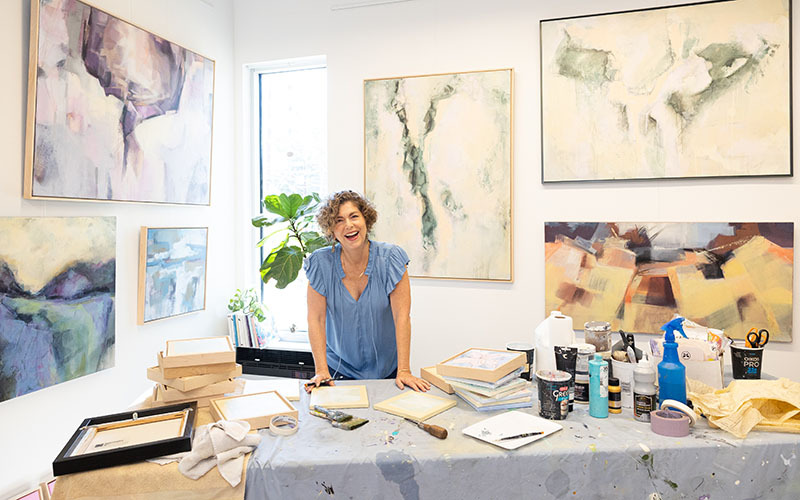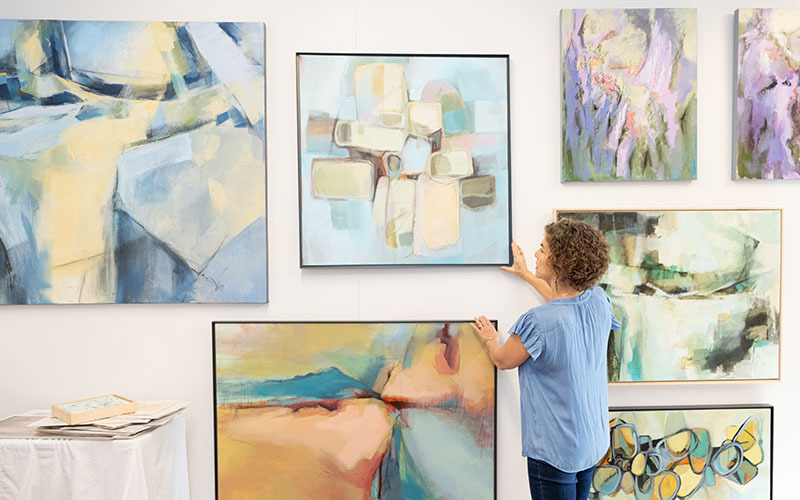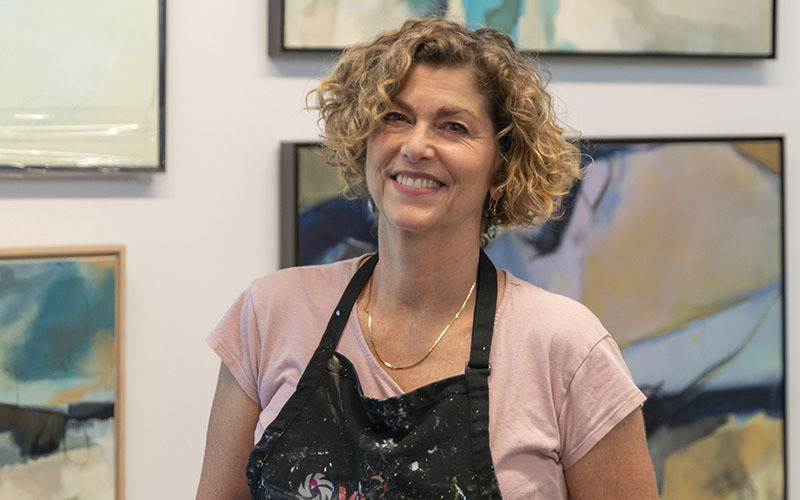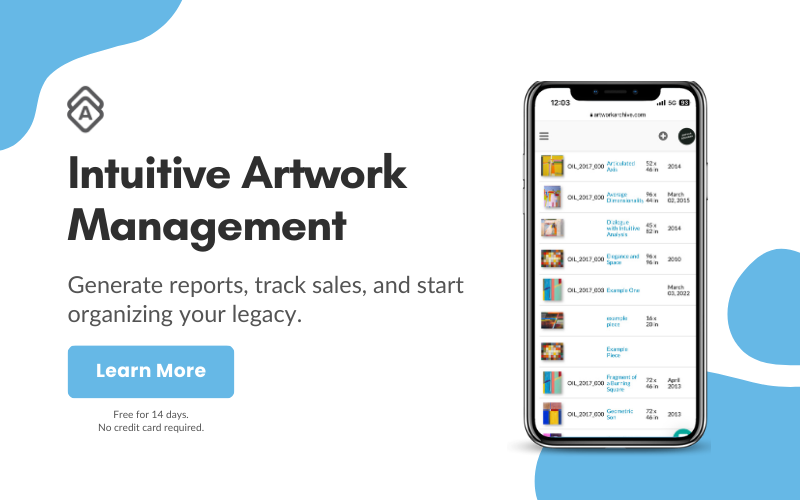To become the artist she always wanted to be, Ann Flemings found that a little structure makes a huge difference.
When making her work, contemporary abstract painter Ann Flemings thrives on experimentation. Her complex paintings can include marks from acrylic, charcoal, oil sticks, gesso, and other expressive, tactile mediums as the situation demands.
“My process is intuitive and layered,” she explains, “embracing spontaneity and texture to bring depth to my work.”
But as she was developing this liberating approach to her creative life, she came to an important realization. To remain free when making art, Flemings found that she had to be carefully structured when it came to the business side of her practice. It wasn’t until she found Artwork Archive that this whole system clicked into place.
Now, her weekly plan allows her to flow seamlessly and stress-free between painting and administrative tasks: “Rather than seeing these two sides as competing forces, I treat them as complementary,” she explains.
In this installment of our Art Business Diaries series, Flemings provides an in-depth review of Artwork Archive, and shares how how the time-blocking and inventory tools she uses can bring structure to any artist’s workflow.
Ann realized that spreadsheets weren’t working for her art business.
Like many artists, Flemings began with basic organizational tools that quickly proved inadequate.
She started with simple spreadsheets: "I found a way to insert small images into the cells to help identify each piece,” she recalls. “But it was a tedious, time-consuming process that made the file bulky and difficult to manage.”
The turning point came through a colleague's recommendation. "I discovered Artwork Archive through the recommendation of another artist, and it felt like a small miracle of efficiency!" she shares.
Because she already had her inventory laboriously stored away in those spreadsheets, she didn’t want to start from square one with Artwork Archive either. "The Artwork Archive team seamlessly transferred my existing spreadsheet into the platform, eliminating the need to start from scratch—an absolute game changer."
Tip: Migrating your inventory might not be as hard as you think:
Transitioning from one collection management system to another may seem daunting, but with Artwork Archive, it doesn’t have to be. Check out your options for migrating your data into Artwork Archive, and if you need an extra hand, reach out to our dedicated team—we’re real people, not a chat bot!—who can help you through the steps.Getting all of her pieces into Artwork Archive shifted something in her mindset around administrative work—instead of thinking of organization as a burden she had to get through, she started thinking of it as something vital that aids the rest of her practice.
"Now, my inventory is organized, easily accessible, and far more manageable, allowing me to focus more on creating and less on administrative tasks," Flemings explains.
Flemings arranging pieces in her studio.
Time-blocking her week saves her art business from scary backlogs.
In her sunny studio in Austin, Texas, Flemings dedicates about 15-20 hours a week to her practice. She says that she typically paints in the afternoons, “allowing time for creative energy to build and flow" for her gestural, textured paintings.
But she also makes sure to schedule time for her administrative tasks—the marketing, administration, and outreach so vital to a sustainable art business. And with Artwork Archive’s suite of tools, these tasks are easier than they’ve ever been for her.
"Rather than seeing these two sides as competing forces, I treat them as complementary," she explains. “I set aside one to two hours daily for emails, updating digital files, preparing submission applications, and scheduling social media posts."
For many artists, these business tasks can feel like unwelcome interruptions to the creative process. But planning them into her day has allowed Flemings to take the pressure off these tasks—rather than rushing to complete a backlog of all her administrative tasks, she tackles a steady, manageable flow of work, which adds up over time to supporting a thriving practice.
"The structure of my business tasks keeps me focused and provides a framework that supports my creative freedom," she notes.
For artists, presentation is everything.
When she discovered Artwork Archive, it was like a lightbulb had been turned on: all the small-but-time-consuming tasks she was used to putting off suddenly seemed manageable.
Take the example of creating labels for shows and shipping: "Before discovering Artwork Archive, I was manually printing labels, affixing them to small bits of foam core, and painstakingly trimming them with a straight edge—an incredibly time-consuming and frustrating process," she remembers.
"Now, with just a few clicks, I can generate a report, and my labels are ready to go. It's seamless, efficient, and an absolute lifesaver!"
Tip: Learn how to easily create labels in Artwork Archive:
Present yourself professionally for your next show—create custom labels that can show the dimensions, medium, creation year, price, and other key details about your artwork.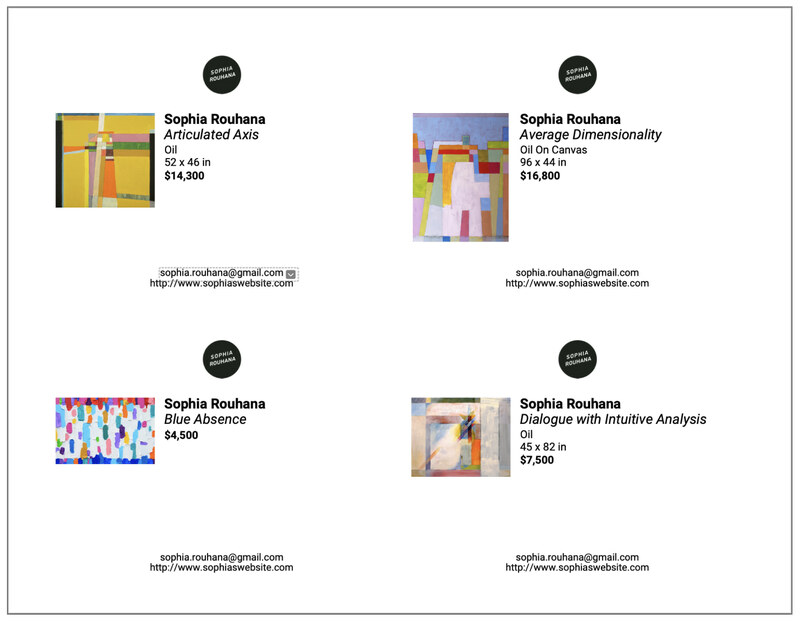
This efficiency extends to how she presents her work to potential buyers.
"I also love the Portfolio and Private Room features. These tools allow me to share my work effortlessly with potential buyers and interior designers," she says. "Not only does this streamlined presentation impress designers with how organized I am, but it also makes it easy for collectors to view high-quality images of my work and envision pieces in their home or office."
Flemings also makes it easy for interested clients to find out more about her work by adding QR codes to her labels: "I generate a QR code for my public profile and print it directly on my art labels. This allows studio visitors to easily access a digital landing page with all the details about my work—something they can take with them and refer to later when considering a piece for their home or office."
When your presentation is polished, your art—and your business—command more respect.
Beyond efficiency, Flemings has discovered that organizational systems enhance how collectors perceive her work. The professional presentation becomes part of the art's value.
When she presents clients with Artwork Archive’s Certificate of Authenticity, “they are always so impressed when I provide this for them with my original artwork," she notes. "It raises the profile of my business and helps to build trust with the client. Which of course, helps nurture repeat business."
This professionalism extends to every interaction with potential buyers, gallery owners, and interior designers. When Flemings can quickly access information about her work, respond to inquiries promptly, and present her portfolio professionally, it signals that she takes her art practice seriously—which encourages others to do the same.
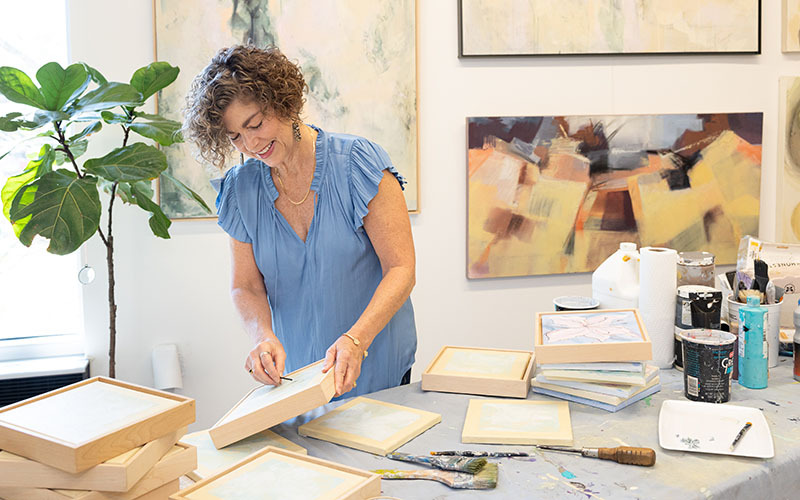 A simple shift in mindset when it comes to adminstrative work can make a big difference, Flemings has found.
A simple shift in mindset when it comes to adminstrative work can make a big difference, Flemings has found.
Four Pieces of Advice for Artists Building Structure in Their Art Business
Flemings offers four key pieces of advice for artists looking to build more structure into their practice:
- Prioritize Organization as Part of Your Art Practice: “Get organized! This is one of the most valuable pieces of advice I can offer," Flemings emphasizes. Rather than viewing organization as separate from art-making, she suggests seeing it as an integral component of a sustainable art practice. "When your artwork details, sales records, and submissions are easily accessible in one place, it streamlines everything—from applying to exhibitions to closing sales."
- Invest Time Upfront for Long-Term Benefits: The initial investment in setting up systems pays dividends over time. "It's easy to fall into disorganization, but taking the time to get things in order is absolutely worth it," Flemings says. Artists often resist organization because of the upfront time commitment, but her experience shows that the hours you invest quickly pay for themselves in time saved and opportunities gained.
- Don’t Understimate the Power of Momentum: Consistency is key to maintaining organizational systems. "Treat it like any other part of your art practice—build it into your routine so that it becomes second nature," she suggests. "Once you're set up, stay on top of it by dedicating a little time each week to maintaining your files and records." By designating specific times for administrative work, artists can prevent backlog and maintain momentum.
- See Business and Creativity as Complementary Forces: Perhaps most importantly, Flemings encourages artists to reframe their relationship with the business side of art. Rather than viewing business tasks as necessary evils that detract from creativity, she sees them as complementary activities that create the conditions for creative work to thrive. "A little consistency goes a long way in keeping your business running smoothly and professionally!" she notes.
Turn chaos into clarity—so you can focus on creating, not catching up.
"Artwork Archive supported me in the early stages of my career and has grown with me along the way," Flemings says. "I still have more to achieve, and I look forward to continuing the journey with Artwork Archive by my side."
As Ann Flemings shows, it might be easier than you think to find peace with the administrative side of your art practice.
For artists who struggle with the business side of their practice, there’s a lesson here: perhaps structure isn't the enemy of creativity but its essential partner. When business systems are functioning well, they create the space, security, and foundation for you to take the creative risks you’ve been dreaming about.
After all, as Flemings discovered, the goal of organization isn't just organization itself—it's creating more time and mental space for what matters most: making art. "Artwork Archive has helped me streamline and focus on the business side of my art, which in turn has created more space for my creativity," she concludes. "And isn't that what we all want—more time to make and create?"
